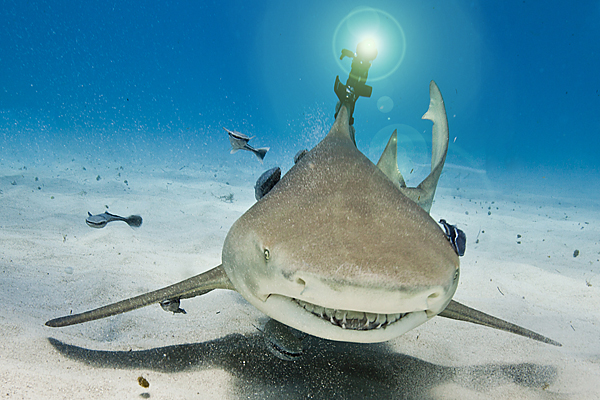[youtube=http://www.youtube.com/watch?v=-v7k6-eEBrk]
Dr. Evil had one simple request to properly arm his lair – he wanted “sharks with frickin’ laser beams attached to their heads.” While his right-hand man Number Two couldn’t deliver on this rather simple setup (instead, he offered ill-tempered sea bass), Australian marine biologist-turned-TV host Luke Tipple was able to turn it into reality.
To be sure, this lemon shark with a laser clamped to its dorsal fin won’t be zapping any evildoers into a fiery pile of rubble, but it fulfills a fantasy of movie buffs – and of course, evil doctors – everywhere.
Tipple, working with the Hong Kong-based company Wicked Lasers, skillfully attached the high-tech laser gadgetry to the ocean’s most feared predator by using a special, non-invasive clamp on the shark’s dorsal fin. The result: a shark with a laser beam attached to its head. It sounds like such a popular yet simple concept, so why had this never been attempted before? Well, simply because of the danger of working with such untrained and potentially dangerous actors.
(LIST: Top 10 Unforgettable Shark Moments)
That’s why Wicked Lasers recruited Tipple, an experienced biologist and perennial Shark Week guest, for the project. He’s spent much of his career working around great white sharks, the species that has most often attacked humans. “Sharks respect predatory behavior,” he tells TIME. “If you know how to behave, they’ll respect you as either a predator or a competitor.”

Moondog / What We Do Media
While on a diving trip in the Bahamas in April, Tipple took the opportunity to test out a shark fin attachment he’s been developing, a piece of hardware that he hopes to mount a camera on to capture footage from a shark’s-eye view. But at Wicked Lasers’ request, he fit a laser onto the device and took it under the Caribbean for a test drive. “As I lurched toward him, he naturally floated away,” Tipple says, explaining that’s what any animal – and probably any human, too – would do if approached. But he easily clipped the laser onto the shark’s dorsal fin and flipped on the laser. Dr. Evil’s long-dreamt predatory double-threat was officially a reality.
And it was all in the name of science, though with a bit of a promotional spin for the modified 150mW S3 Krypton laser that protruded from the shark’s head. Better still, no sharks were hurt, not even a little, in the making of the ad. Tipple, who has been working on the clip-on device for many months, says it was a “coincidence” that he was able to test now. It doesn’t pierce the shark’s skin and can be easily removed; even if the shark swam away, the clip’s spring would rust and break apart within weeks. And the dorsal fin is just a mass of cartilage, Tipple explains. “It probably felt a slight bit of pressure, but realistically, not much.” The shark, which they affectionately named Mr. Bigglesworth after Dr. Evil’s diabolic yet loveable cat, swam around unfazed.
Which may have come as a bit of a surprise to Tipple. In addition to his biology credits, he’s also the director of the Humane Society’s Shark-Free Marina Initiative seeking to stop shark hunting and cruelty, which is why at first he declined Wicked Lasers’ request. “Everything I’m involved with has to be ethical and justifiable,” Tipple notes. But once he realized the project was meant in good fun and had scientific implications, too, he decided to round up the necessary manpower. “It casts sharks in exactly the right light,” he notes. “I haven’t seen news pieces like these in years, if ever.” And we’ve never seen sharks look quite so awesome.
MORE: Top 10 Things You Didn’t Know About Sharks

Moondog / What We Do Media






